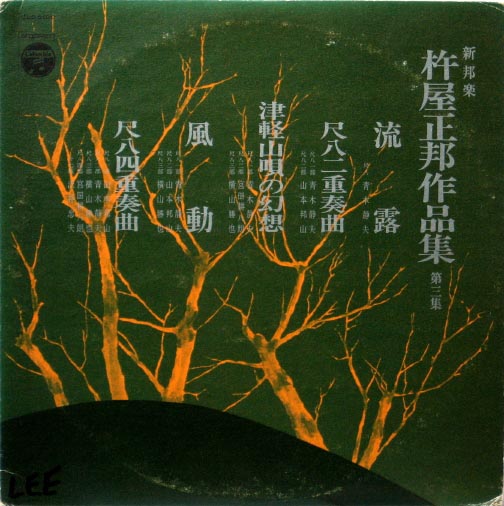Kineya Seihō
杵屋 正邦

10/7/1914 - 2/6/1996
Koto
|
Born in Honjo, Tokyo. He studied Nagauta under his father, Shoshirō Kuchiya, from an early age. From around 1918, he participated in tours as a Kabuki shamisen player and received Kabuki. Started composing activities around 1945. Since 1948, he has studied composition method and Western music theory under Akihiro Norimatsu. In his early days he was both a performer and a composer, but eventually he became a composer. His works cover more than a thousand songs, and cover all fields such as instrumental music and voice music by Western instruments. In charge of songs in plays such as NHK Taiga dramas for many years. He has a lot of performing arts, not only new Kabuki (Shochiku) but also contemporary drama (Bungakuza, Toho, Shinpa, etc.), commercial theater (Hideki Takahashi performance, Hibari Misora performance, Takarazuka Revue, Shochiku Opera, etc.), a wide range of songs from creative butoh songs to in-movie songs. He was involved with the NHK Japanese Music Skills Training Association, which started in 1955 with the aim of fostering performers who can perform ensemble regardless of the type and school of musical instruments. After working as a permanent lecturer for 40 years, he retired after receiving a letter of appreciation from the chairman commemorating the 70th anniversary of the start of NHK broadcasting in March 1995.
|
Estudiantes
|
Álbumes
 |
Kineya Seiho Sakuhin Shû Performance of Kineya Seiho Compositions |
Compuesto o Arreglado
| Shakuhachi Obras | |||
| Título | Kanji | Año | Título Alternativo |
| Danryu | 暖流 |
||
| Gensokyoku Urabon | Fantasy Urabon | ||
| Ginyu | 吟游 |
Floating Chants | |
| Hazakai | はざかい |
||
| Henro | 遍路 |
A Pilgrim's Song | |
| Hyojo no Gassokyoku | 平調の合奏曲 |
Ensemble piece in hyojo | |
| Ichiju no Kage | 一樹のかげ |
||
| Ikkan Sanko | 一管三鼓 |
||
| Iwa ni Natta On'na | 岩になった女 |
||
| Kobo | 光芒 |
||
| Koma no Kyoku | |||
| Tsugaru Yama Uta no Gensô | 津軽山唄の幻想 |
||
| Yōshun | 陽春 |
||
| Meikyo | 明鏡 |
1950 |
|
| Shakuhachi Nijūsōkyoku | 尺八二重奏曲 |
1961 |
Shakuhachi duo |
| Shakuhachi Shijūsōkyoku | 尺八四重奏曲 |
1961 |
Shakuhachi quartet |
| Min'yo Kumikyoku Tohoku Hen | 1962 |
Suite for Japanese instruments Tohoku hen | |
| Nikan Shigen | 二管四絃 |
1964 |
|
| Somei | 奏鳴 |
1964 |
|
| Fūdō | 風動 |
1965 |
|
| Hinaburi Dai Isshu | ひなぶり第1集 |
1965 |
Hineburi 1st chapter |
| Hinaburi Dai Nishu | ひなぶり第2集 |
1966 |
Hinaburi 2nd chapter |
| Kaki to Yamabushi | 柿と山伏 |
1966 |
|
| Gunjobushi no Shudai ni Yoru Hensokyoku | 郡上節の主題による変奏曲 |
1967 |
Variations on a theme of Gujobushi |
| Ryûro | 流露 |
1967 |
|
| Hazama | はざま |
1968 |
|
| Shakuhachi Sanjūsōkyoku Daini Fūdō | 尺八三重奏曲第二風動 |
1968 |
Shakuhachi trio Daini fudo |
| Wakasa Nenbutsu ni Yoru Composition | 若狭念仏によるコンポジション |
1968 |
Composition on Wakasa nenbutsu |
| Gin'yu | 吟遊 |
1969 |
|
| Daisan Fudo | 第3風動 |
1970 |
N/A |
| Gojusokyoku | 五重奏曲 |
1970 |
Quintet for 3 sakuhachi - koto and jushichigen |
| Ichijō | 一定 |
1970 |
Certainty |
| Daiyon Fudo | 第4風動 |
1981 |
|
| Koto | |||
| Kira | 綺羅 |
||
| Wave - Koto Duet | 箏二重奏曲 「波」 |
||
| Shamisen | |||
| Meikyo | 明鏡 |
1975 |
|
| Kyorai | 去来 |
1976 |
